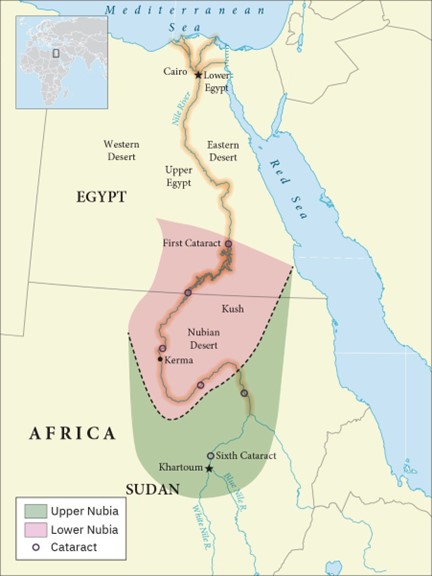7 The Kingdom of Kush
Located in the fertile Nile Valley, south of Egypt, the ancient kingdom of Kush emerged as a major power in the ancient world. With a rich history spanning over 3,000 years, Kush developed a unique culture that blended Egyptian, African, and Mediterranean influences. From its early beginnings as a small Nubian kingdom to its rise as a mighty empire that rivaled Egypt, Kush left an indelible mark on the ancient world.
The Kingdom of Kush: A Blend of Cultures
The first cataract of the Nile River marked the traditional southern boundary of Ancient Egypt. This natural barrier limited Egyptian influence southward, allowing distinct cultures and kingdoms to emerge in Nubia, a vast territory stretching into sub-Saharan Africa. The Kingdom of Kush was the first to arise in Nubia, and its strategic location along the Nile River meant that it was heavily influenced by Egyptian culture throughout its history.

Despite Egyptian influence, Kush developed its own unique traditions, culture, language, and history. The kingdom flourished from around 1070 BCE to 350 CE, with its capital, Meroe, becoming an important center of trade and culture. Kush was known for its impressive architectural achievements, including the construction of numerous pyramids, and its distinct identity reflected its African heritage and position as a bridge between Egyptian and sub-Saharan African cultures.
Link to Learning
Use these links to explore the Nubian art collection (https://openstax.org/l/77NubianArt) and Egyptian collection (https://openstax.org/l/77EgyptArt) at the Museum of Fine Arts, Boston.
The Kingdom of Kush: A Blend of Cultures
The earliest Nubian state arose around 2400 BCE, with the city of Kerma becoming a major center of trade and culture. The Egyptians referred to Kerma as “Kush,” and the city’s wealth and prosperity were symbolized by its great walls, palace, and religious buildings. The Western Deffufa, a large temple in Kerma, was an important center of religious ceremonies, possibly involving ancestor worship.
As Egyptian power expanded southward, trade and cultural exchange increased, and the area became increasingly wealthy. The Egyptians established fortresses to consolidate their control over regional trade, and the Nubian city-state of Kerma was absorbed into the Egyptian empire. However, with the decline of the New Kingdom and the beginning of Egypt’s Third Intermediate Period, local leaders in Nubia reasserted their independence, and a new independent Kushite kingdom emerged around the city of Napata.
By the 8th century BCE, the Kushite kingdom was growing in power and influence, and King Piye managed to install his sister as high priestess of Amun in Thebes, asserting Kushite authority over Upper Egypt. This led to a period of Nubian rule in Egypt, known as the Twenty-Fifth Dynasty or the Ethiopian dynasty. The Nubian leaders who ruled Egypt during this period were thoroughly Egyptianized in culture and religious traditions, preserving Egyptian cultural practices and traditions to strengthen their legitimacy.
The rise of the Neo-Assyrian Empire brought an end to Nubian rule in Egypt, and the Kushite leadership fled to a new capital, Meroe. Meroe became an important trading center, with iron, wood, elephants, and ivory flowing out to the wider world. The city was known for its distinctive jewelry and skilled artisans, and its wealth was renowned. The Meroitic period of the Kingdom of Kush saw the development of a unique culture, blending Egyptian, African, and local influences.
The Meroitic rulers constructed pyramids for their rulers, albeit smaller and with steeper sides than those in Egypt. The use of Egyptian hieroglyphs continued, eventually giving way to the Meroitic script. Egyptian religious practices persisted, with the worship of the lion-headed god Apademak becoming a distinctive feature of Kushite religion.
Gender Roles in Ancient Kush
In Ancient Kush, gender roles were relatively fluid, with women playing significant roles in politics, trade, and religion. One notable example is Queen Amanirenas, who ruled from around 20 BCE to 10 BCE and led a successful military campaign against the Romans in 20 BCE. She was known for her bravery and strategic leadership, and her reign marked a period of significant power and influence for the Kingdom of Kush. Women also held important positions in the priesthood, with some even serving as high priestesses of the god Amun. This level of female empowerment was rare in the ancient world, making Kush a unique and fascinating civilization.
The Legacy of Kush
The Kingdom of Kush, which flourished from 1070 BCE to 350 CE, left a lasting legacy in the history of Africa and the ancient world. Its unique blend of Egyptian, African, and Mediterranean influences created a distinct culture that continues to inspire wonder and awe. The Kushite pyramids, temples, and artifacts remain an important part of Africa’s cultural heritage, while the kingdom’s strategic position as a bridge between Egypt and sub-Saharan Africa facilitated the exchange of ideas, goods, and innovations. Furthermore, the Kingdom of Kush’s emphasis on female empowerment and leadership paved the way for future generations of women in Africa and beyond. The legacy of Kush also extends to the modern-day Nubian people, who continue to celebrate their heritage and cultural traditions. As a testament to its enduring impact, the Kingdom of Kush remains an important chapter in the story of human civilization.
